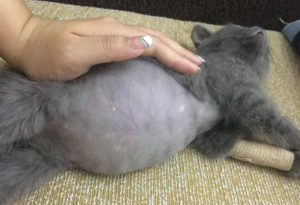Recently, a pet owner took their cat for a routine check-up and was told by the vet that the cat was carrying the coronavirus. This made the owner very worried, fearing that the cat had contracted FIP.
In fact, a cat carrying the coronavirus does not necessarily mean it has FIP. The relationship between the cat coronavirus and FIP is not very clear to many people, so this article will detail the differences between the cat coronavirus and FIP.

The feline coronavirus (FCoV) is an enveloped RNA virus with a genome consisting of 29,190 nucleotides. It has two known biotypes, one is the enteric coronavirus (FECV), and the other is the feline infectious peritonitis virus (FIPV).
In daily life, the cat coronavirus we usually refer to is the enteric coronavirus. The enteric coronavirus usually exists in the cat’s intestines, and about 20% to 60% of pet cats can detect this antibody. For some households with multiple pet cats, the positive rate of antibodies can sometimes reach 100%. The enteric coronavirus is highly contagious and is mainly transmitted through feces and the digestive tract.
Under normal circumstances, infection with the enteric coronavirus usually only causes mild disease symptoms. Most do not show clinical symptoms, some kittens will have continuous mild diarrhea, and a few cases may vomit.

The feline peritonitis virus, on the other hand, is a mutation of the enteric coronavirus. It is not contagious, but it can cause cats to suffer from infectious peritonitis, i.e., FIP.
FIP is a disease with a variety of clinical manifestations. Its incidence is relatively low, and the mortality rate is high. It was once considered a terminal illness. However, in recent years, drugs have appeared that can cure FIP. As long as medication is timely, cats with FIP can generally recover.
FIP can be divided into wet FIP and dry FIP according to different symptoms:
The typical characteristic of wet FIP is that the cat’s belly is swollen, there is high-protein exudate in the thoracic and abdominal cavities, and depending on the amount of abdominal fluid, symptoms can range from asymptomatic to panting or difficulty breathing. Vomiting or diarrhea, moderate to severe anemia may also occur. Clinical examinations will find progressive muscle wasting on both sides of the spine, and progressive enlargement of the abdomen.

Dry FIP mainly causes granulomatous lesions of the organs. Cats may show progressive weight loss, jaundice, eye changes such as cloudy eyes, miosis, visual impairment, and other symptoms. A few are accompanied by multiple progressive neurological symptoms, including hind limb paralysis, spasms, and eye tremors. Nodules can be palpated in the liver, kidney, spleen, retina, and lymph nodes, and nodules of the mesenteric lymph can be felt on physical examination.
So, why does the enteric coronavirus mutate into the peritonitis virus? The reason is due to the poor immunity of the cat, which is also why most cats with FIP are under two years old or elderly cats.
Therefore, if you want your cat to stay away from FIP, avoid the enteric coronavirus mutating into the peritonitis virus, or avoid contact with the coronavirus, prevention is key!
It is always better to prepare for a rainy day than to be caught off guard when the disease strikes. Therefore, in daily life, it is important to create a good living environment for your cat, reduce stress reactions, ensure nutrient absorption to improve immunity. As long as the immunity is good enough, it is difficult for the enteric coronavirus to mutate. If you find that the cat has suspicious symptoms, you should seek medical attention in time and do not delay the cat’s best treatment opportunity.


Should FIP treatment be given to a cat that just carries the virus without being yet sick?